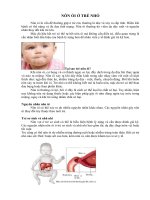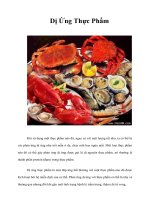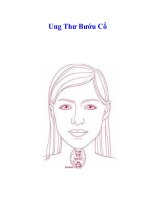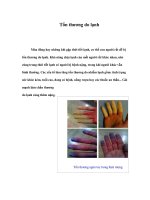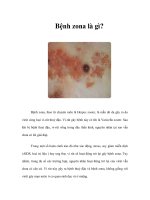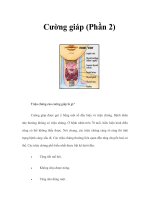Tài liệu Dynamics of Human Gait docx
Bạn đang xem bản rút gọn của tài liệu. Xem và tải ngay bản đầy đủ của tài liệu tại đây (3.12 MB, 153 trang )
2nd Edition
2nd Edition
DYNAMICS OF
HUMAN GAIT
DYNAMICS OF
HUMAN GAIT
Christopher L Vaughan
Brian L Davis
Jeremy C OConnor
Christopher L Vaughan
Brian L Davis
Jeremy C OConnor
Dynamics
of
Human Gait
(Second Edition)
Christopher L Vaughan, PhD
University of Cape Town
Brian L Davis, PhD
Cleveland Clinic Foundation
Jeremy C OConnor, BSc (Eng)
University of Cape Town
Kiboho Publishers
Cape Town, South Africa
South African State Library Cataloguing-in-Publication Data
Vaughan, Christopher L
Dynamics of human gait / Christopher L Vaughan, Brian L Davis, Jeremy C OConnor
Includes bibliographical references and index.
1. Gait in humans
I Title
612.76
ISBN: 0-620-23558-6 Dynamics of Human Gait (2nd edition) by CL Vaughan, BL Davis and
JC OConnor
ISBN: 0-620-23560-8 Gait Analysis Laboratory (2nd edition) by CL Vaughan, BL Davis and
JC OConnor
First published in 1992
Copyright 1999 by Christopher L Vaughan
All rights reserved. Except for use in a review, the reproduction or utilisation of this work in any form or
by any electronic, mechanical, or other means, now known or hereafter invented, including xerography,
photocopying and recording, and in any information storage and retrieval system, is forbidden without
the written permission of the publisher. The software is protected by international copyright law and
treaty provisions. You are authorised to make only archival copies of the software for the sole purpose
of backing up your purchase and protecting it from loss.
The terms IBM PC, Windows 95, and Acrobat Reader are trademarks of International Business Machines,
Microsoft and Adobe respectively.
Editor: Christopher Vaughan
CD Replication: Sonopress South Africa
Text Layout: Roumen Georgiev and Narima Panday
Software Design: Jeremy OConnor, Michelle Kuttel and Mark de Reus
Cover Design: Christopher Vaughan and Brian Hedenskog
Illustrations: Ron Ervin, Christopher Vaughan and Roumen Georgiev
Printer: Mills Litho, Cape Town
Printed in South Africa
Kiboho Publishers
P.O. Box 769
Howard Place, Western Cape 7450
South Africa
/>e-mail:
This book is dedicated to our families:
Joan, Bronwyn and Gareth Vaughan;
Tracy, Sean and Stuart Davis;
and
the OConnor Family.
v
Contents
About Dynamics of Human Gait vii
About Gait Analysis Laboratory ix
Acknowledgments xi
Chapter 1 In Search of the Homunculus 1
Top-Down Analysis of Gait 2
Measurements and the Inverse Approach 4
Summary 6
Chapter 2 The Three-Dimensional and Cyclic Nature of Gait 7
Periodicity of Gait 8
Parameters of Gait 12
Summary 14
Chapter 3 Integration of Anthropometry, Displacements,
and Ground Reaction Forces 15
Body Segment Parameters 16
Linear Kinematics 22
Centres of Gravity 29
Angular Kinematics 32
Dynamics of Joints 36
Summary 43
Chapter 4 Muscle Actions Revealed Through Electromyography 45
Back to Basics 45
Phasic Behaviour of Muscles 52
Relationship Between Different Muscles 55
Summary 62
Chapter 5 Clinical Gait Analysis A Case Study 63
Experimental Methods 64
Results and Discussion 65
Summary 76
vi
Appendix A Dynamic Animation Sequences 77
Appendix B Detailed Mathematics Used in GaitLab 83
Appendix C Commercial Equipment for Gait Analysis 107
References 133
Index 137
CONTENTS
vii
About Dynamics
of Human Gait
This book was created as a companion to the GaitLab software package.
Our intent was to introduce gait analysis, not to provide a comprehensive
guide. We try to serve readers with diverse experience and areas of interest
by discussing the basics of human gait as well as some of the theoretical,
biomechanical, and clinical aspects.
In chapter 1 we take you in search of the homunculus, the little being
inside each of us who makes our walking patterns unique. We represent the
walking human as a series of interconnected systems neural, muscular,
skeletal, mechanical, and anthropometric that form the framework for
detailed gait analysis.
The three-dimensional and cyclical nature of human gait is described in
chapter 2. We also explain how many of the relevant parameters can be
expressed as a function of the gait cycle, including kinematics (e.g., height of
lateral malleolus), kinetics (e.g., vertical ground reaction force), and muscle
activity (e.g., EMG of rectus femoris).
In chapter 3 we show you how to use the framework constructed in the
first two chapters to integrate anthropometric, 3-D kinematic, and 3-D force
plate data. For most readers this will be an important chapter it is here
that we suggest many of the conventions we believe to be lacking in three-
dimensional gait analysis. Although conceptually rigorous, the mathemati-
cal details are kept to a minimum to make the material accessible to all stu-
dents of human motion. (For the purists interested in these details, that infor-
mation is in Appendix B.)
In chapter 4 we describe the basics of electromyography (EMG) and how
it reveals the actions of the various muscle groups. We discuss some of the
techniques involved and then illustrate the phasic behaviour of muscles dur-
ing the gait cycle and describe how these signals may be statistically analysed.
One of the purposes of this book is to help clinicians assess the gaits of
their patients. Chapter 5 presents a case study of a 23 year-old-man with
cerebral palsy. We have a complete set of 3-D data for him that can be
processed and analyzed in GaitLab.
Beginning in Appendix A we use illustrated animation sequences to em-
phasize the dynamic nature of human gait. By carefully fanning the pages of
viii
the appendixes, you can get a feel for the way the human body integrates
muscle activity, joint moments, and ground reaction forces to produce a
repeatable gait pattern. These sequences bring the walking subject to life
and should provide you with new insights.
The detailed mathematics used to integrate anthropometry, kinematics,
and force plate data and to generate 3-D segment orientations, and 3-D joint
forces and moments are presented in Appendix B. This material, which is
the basis for the mathematical routines used in GaitLab, has been included
for the sake of completeness. It is intended for researchers who may choose
to include some of the equations and procedures in their own work.
The various pieces of commercially available equipment that may be used
in gait analysis are described and compared in Appendix C. This summary
has been gleaned from the World Wide Web in late 1998 and you should be
aware that the information can date quite rapidly.
Dynamics of Human Gait provides a solid foundation for those new to
gait analysis, while at the same time addressing advanced mathematical tech-
niques used for computer modelling and clinical study. As the first part of
Gait Analysis Laboratory, the book should act as a primer for your explora-
tion within the GaitLab environment. We trust you will find the material
both innovative and informative.
ABOUT DYNAMICS OF HUMAN GAIT
ix
About Gait Analysis
Laboratory
Gait Analysis Laboratory has its origins in the Department of Biomedical
Engineering of Groote Schuur Hospital and the University of Cape Town. It
was in the early 1980s that the three of us first met to collaborate on the
study of human walking. Our initial efforts were simple and crude. Our
two-dimensional analysis of children with cerebral palsy and nondisabled
adults was performed with a movie camera, followed by tedious manual
digitizing of film in an awkward minicomputer environment. We concluded
that others travelling this road should have access on a personal com-
puter to material that conveys the essential three-dimensional and dy-
namic nature of human gait. This package is a result of that early thinking
and research.
There are three parts to Gait Analysis Laboratory: this book, Dynamics of
Human Gait, the GaitLab software, and the instruction manual on the inside
cover of the CD-ROM jewel case. In the book we establish a framework of
gait analysis and explain our theories and techniques. One of the notable
features is the detailed animation sequence that begins in Appendix A. These
walking figures are analogue counterparts to the digital animation presented
in Animate, the Windows 95 software that is one of the applications in the
GaitCD package. GaitLabs sizable data base lets you explore and plot more
than 250 combinations of the basic parameters used in gait analysis. These
can be displayed in a variety of combinations, both graphically and with stick
figure animation.
Weve prepared this package with the needs of all students of human move-
ment in mind. Our primary objective has been to make the theory and tools
of 3D gait analysis available to the person with a basic knowledge of me-
chanics and anatomy and access to a personal computer equipped with Win-
dows 95. In this way we believe that this package will appeal to a wide
audience. In particular, the material should be of interest to the following
groups:
Students and teachers in exercise science and physiotherapy
Clinicians in orthopaedic surgery, physiotherapy, podiatry,
x
rehabilitation, neurology, and sports medicine
Researchers in biomechanics, kinesiology, biomedical engineering, and
the movement sciences in general
Whatever your specific area of interest, after working with Gait Analysis
Laboratory you should have a much greater appreciation for the human lo-
comotor apparatus, particularly how we all manage to coordinate move-
ment in three dimensions. These powerful yet affordable tools were de-
signed to provide new levels of access to the complex data generated by a
modern gait analysis laboratory. By making this technology available we
hope to deepen your understanding of the dynamics of human gait.
ABOUT GAIT ANALYSIS LABORATORY
xi
Acknowledgements
First Edition
We are grateful to all those who have enabled us to add some diversity to our
book. It is a pleasure to acknowledge the assistance of Dr. Peter Cavanagh,
director of the Center for Locomotion Studies (CELOS) at Pennsylvania
State University, who provided the plantar pressure data used for our anima-
tion sequence, and Mr. Ron Ervin, who drew the human figures used in the
sequence.
Dr. Andreas von Recum, professor and head of the Department of Bioengi-
neering at Clemson University, and Dr. Michael Sussman, chief of Paediatric
Orthopaedics at the University of Virginia, provided facilities, financial sup-
port, and substantial encouragement during the writing of the text.
The three reviewers, Dr. Murali Kadaba of Helen Hayes Hospital, Dr.
Stephen Messier of Wake Forest University, and Dr. Cheryl Riegger of the
University of North Carolina, gave us substantial feedback. Their many sug-
gestions and their hard work and insights have helped us to make this a
better book.
We are especially grateful to Mrs. Nancy Looney and Mrs. Lori White,
who helped with the early preparation of the manuscript.
Appendix C, Commercial Equipment for Gait Analysis, could not have
been undertaken without the interest and cooperation of the companies men-
tioned.
The major thrust of Gait Analysis Laboratory, the development of GaitLab,
took place in June and July of 1988 in Cape Town. We especially thank Dr.
George Jaros, professor and head of the Department of Biomedical Engi-
neering at the University of Cape Town and Groote Schuur Hospital. He
established an environment where creativity and collaboration flourished.
We also acknowledge the financial support provided by the university, the
hospital, and the South African Medical Research Council.
Much of the conceptual framework for Gait Analysis Laboratory was de-
veloped during 1983-84 in England at the University of Oxfords Ortho-
paedic Engineering Centre (OOEC). Dr. Michael Whittle, deputy director,
and Dr. Ros Jefferson, mathematician, provided insight and encouragement
during this time. They have maintained an interest in our work and recently
shared some of their kinematic and force plate data, which are included in
GaitLab.
The data in chapters 3 and 5 were provided by Dr. Steven Stanhope, direc-
tor, and Mr. Tom Kepple, research scientist, of the Biomechanics Labora-
tory at the National Institutes of Health in Bethesda, Maryland; and by Mr.
xii
George Gorton, technical director, and Ms. Patty Payne, research physical
therapist, of the Motion Analysis Laboratory at the Childrens Hospital in
Richmond, Virginia. Valuable assistance was rendered by Mr. Francisco
Sepulveda, graduate student in bioengineering, in the gathering and analysis
of the clinical data.
Finally, it is a pleasure to acknowledge the efforts of the staff at Human
Kinetics. We make special mention of Dr. Rainer Martens, publisher, Dr.
Rick Frey, director of HK Academic Book Division, and Ms. Marie Roy and
Mr. Larret Galasyn-Wright, developmental editors, who have been enthusi-
astic, supportive, and above all, patient.
Second Edition
Since the first edition was published seven years ago, there have been other
people who have provided significant input to this second edition.
At the University of Virginia, from 1992-1995, the Motion Analysis Labo-
ratory provided an important intellectual home. Ms. Stephanie Goar, labo-
ratory manager, assisted with the preparation of the revised manuscript and
updated the references in the GaitBib database. Dr. Gary Brooking and Mr.
Robert Abramczyk, laboratory engineers, were responsible for gathering and
tracking the expanded set of clinical data files used by the latest version of
GaitLab. The database of 3D kinematic and force plate data for normal
children was assembled by Mr. Scott Colby, graduate student in biomedical
engineering. Mr. Scott Seastrand, architectural student, converted all the
original artwork into computer format for this electronic version of Dynam-
ics of Human Gait. Two fellow faculty members at the University of Vir-
ginia Dr. Diane Damiano, physical therapist, and Dr. Mark Abel, ortho-
paedic surgeon provided important insights regarding the clinical applica-
tions of gait analysis, especially applied to children with cerebral palsy.
By 1996 the wheel had turned full circle and Dr. Kit Vaughan returned to
the University of Cape Town where he re-established contact with Mr. Jer-
emy OConnor. In the Department of Biomedical Engineering, and with the
financial support of the Harry Crossley Foundation and the South African
Foundation for Research Development, the project continued. Computer
programming support was provided by Ms. Michelle Kuttel, graduate stu-
dent in computer science and chemistry, and Mr. Mark de Reus, graduate
student in biomedical engineering. Preparation of the appendices in Dynam-
ics of Human Gait was done by Mrs. Cathy Hole, information specialist, and
Ms. Narima Panday, senior secretary. The desktop publishing of the whole
of Dynamics of Human Gait was performed by Mr. Roumen Georgiev, gradu-
ate student in biomedical engineering.
Finally, it is a pleasure to acknowledge the contribution of Mr. Edmund
Cramp of Motion Lab Systems in Baton Rouge, Louisiana, who provided us
with the software tools to translate binary format C3D files into the text-
based DST files used by the GaitLab package.
ACKNOWLEDGMENTS
IN SEARCH OF THE HOMUNCULUS 1
In Search of
the Homunculus
Homunculus: An exceedingly minute body that according to
medical scientists of the 16th and 17th centuries, was contained
in a sex cell and whose preformed structure formed the basis for
the human body.
Stedmans Medical Dictionary
When we think about the way in which the human body walks, the analogy of a
marionette springs to mind. Perhaps the puppeteer who pulls the strings and
controls our movements is a homunculus, a supreme commander of our locomo-
tor program. Figure 1.1, reprinted from Inman, Ralston, and Todd (1981), illus-
trates this point in a rather humorous but revealing way. Though it seems simplis-
tic, we can build on this idea and create a structural framework or model that will
help us to understand the way gait analysis should be performed.
1
CHAPTER 1
Figure1.1 A homun-
culus controls the
dorsiflexors and plantar
flexors of the ankle, and
thus determines the
pathway of the knee.
Note. From Human
Walking (p. 11) by V.T.
Inman, H.J. Ralston,
and F. Todd , 1981,
Baltimore: Williams &
Wilkins. Copyright
1981 by Williams &
Wilkins. Reprinted by
permission.
2 DYNAMICS OF HUMAN GAIT
Top-Down Analysis of Gait
Dynamics of Human Gait takes a top-down approach to the description of
human gait. The process that we are most interested in starts as a nerve
impulse in the central nervous system and ends with the generation of ground
reaction forces. The key feature of this approach is that it is based on cause
and effect.
Sequence of Gait-Related Processes
We need to recognise that locomotor programming occurs in supraspinal
centres and involves the conversion of an idea into the pattern of muscle activity
that is necessary for walking (Enoka, 1988). The neural output that results
from this supraspinal programming may be thought of as a central locomotor
command being transmitted to the brainstem and spinal cord. The execution
of this command involves two components:
1. Activation of the lower neural centres, which subsequently establish
the sequence of muscle activation patterns
2. Sensory feedback from muscles, joints, and other receptors that
modifies the movements
This interaction between the central nervous system, peripheral nervous system,
and musculoskeletal effector system is illustrated in Figure 1.2 (Jacobsen &
Webster, 1977). For the sake of clarity, the feedback loops have not been
included in this figure. The muscles, when activated, develop tension, which
in turn generates forces at, and moments across, the synovial joints.
Figure 1.2 The seven
components that form
the functional basis for
the way in which we
walk. This top-down
approach constitutes a
cause-and-effect model.
4 Synovial joint
Movement 6
Rigid link segment 5
External forces 7
2 Peripheral nervous system
1 Central nervous system
Muscles 3
IN SEARCH OF THE HOMUNCULUS 3
The joint forces and moments cause the rigid skeletal links (segments such as
the thigh, calf, foot, etc.) to move and to exert forces on the external
environment.
The sequence of events that must take place for walking to occur may be
summarized as follows:
1. Registration and activation of the gait command in the central nervous
system
2. Transmission of the gait signals to the peripheral nervous system
3. Contraction of muscles that develop tension
4. Generation of forces at, and moments across, synovial joints
5. Regulation of the joint forces and moments by the rigid skeletal segments
based on their anthropometry
6. Displacement (i.e., movement) of the segments in a manner that is recog-
nized as functional gait
7. Generation of ground reaction forces
These seven links in the chain of events that result in the pattern of movement
we readily recognize as human walking are illustrated in Figure 1.3.
Clinical Usefulness of the Top-Down Approach
The model may also be used to help us
understand pathology
determine methods of treatment, and
decide on which methods we should use to study patients gait.
For example, a patients lesion could be at the level of the central nervous
system (as in cerebral palsy), in the peripheral nervous system (as in Charcot-
Marie-Tooth disease), at the muscular level (as in muscular dystrophy), or in
the synovial joint (as in rheumatoid arthritis). The higher the lesion, the more
profound the impact on all the components lower down in the movement
chain. Depending on the indications, treatment could be applied at any of the
different levels. In the case of a high lesion, such as cerebral palsy, this
could mean rhizotomy at the central nervous system level, neurectomy at the
Figure 1.3 The sequence
of seven events that lead
to walking. Note. This
illustration of a
hemiplegic cerebral
palsy child has been
adapted from Gait
Disorders in Childhood
and Adolescence (p.
130) by D.H.
Sutherland, 1984,
Baltimore: Williams &
Wilkins. Copyright 1984
by Williams & Wilkins.
Adapted by permission.
1
2
3
4
5
6
7
4 DYNAMICS OF HUMAN GAIT
peripheral nervous system level, tenotomy at the muscular level, or osteotomy
at the joint level. In assessing this patients gait, we may choose to study the
muscular activity, the anthropometry of the rigid link segments, the move-
ments of the segments, and the ground reaction forces.
Measurements and the Inverse Approach
Measurements should be taken as high up in the movement chain as possible,
so that the gait analyst approaches the causes of the walking pattern, not just
the effects. As pointed out by Vaughan, Hay, and Andrews (1982), there are
essentially two types of problems in rigid body dynamics. The first is the
Direct Dynamics Problem in which the forces being applied (by the homuncu-
lus) to a mechanical system are known and the objective is to determine the
motion that results. The second is the Inverse Dynamics Problem in which the
motion of the mechanical system is defined in precise detail and the objective
is to determine the forces causing that motion. This is the approach that the
gait analyst pursues. Perhaps it is now clear why the title of this first chapter is
In Search of the Homunculus!
The direct measurement of the forces and moments transmitted by human
joints, the tension in muscle groups, and the activation of the peripheral and
central nervous systems is fraught with methodological problems. That is
why we in gait analysis have adopted the indirect or inverse approach. This
approach is illustrated verbally in Figure 1.4 and mathematically in Figure 1.5.
Note that four of the components in the movement chain 3, electromyo-
graphy; 5, anthropometry; 6, displacement of segments; and 7, ground reac-
tion forces may be readily measured by the gait analyst. These have been
highlighted by slightly thicker outlines in Figure 1.4. Strictly speaking, elec-
tromyography does not measure the tension in muscles, but it can give us
insight into muscle activation patterns. As seen in Figure 1.5, segment an-
thropometry A
s
may be used to generate the segment masses m
s
, whereas
segment displacements p
s
may be double differentiated to yield accelerations
a
s
. Ground reaction forces F
G
are used with the segment masses and accelera-
tions in the equations of motion which are solved in turn to give resultant joint
forces and moments F
J
.
Figure 1.4 The inverse
approach in rigid body
dynamics expressed in
words.
3
4
7
56
Electromyography
Joint forces
and moments
Equations of
motion
Velocities and
accelerations
Segment
displacements
Ground
reaction forces
Segment masses and
moments of inertia
Anthropometry of
skeletal segments
Tension in
muscles
IN SEARCH OF THE HOMUNCULUS 5
Many gait laboratories and analysts measure one or two of these compo-
nents. Some measure all four. However, as seen in Figures 1.2 to 1.5, the key
to understanding the way in which human beings walk is integration. This
means that we should always strive to integrate the different components to
help us gain a deeper insight into the observed gait. Good science should be
aimed at emphasizing and explaining underlying causes, rather than merely
observing output phenomena the effects in some vague and unstruc-
tured manner.
Whereas Figures 1.4 and 1.5 show how the different measurements of hu-
man gait may be theoretically integrated, Figure 1.6 illustrates how we have
implemented this concept in GaitLab. The four data structures on the left
electromyography (EMG), anthropometry (APM), segment kinematics (KIN),
and ground reaction data from force plates (FPL) are all based on direct
measurements of the human subject. The other parameters body segment
parameters (BSP), joint positions and segment endpoints (JNT), reference
frames defining segment orientations (REF), centres of gravity, their veloci-
Figure 1.5 The inverse
approach in rigid body
dynamics expressed in
mathematical symbols.
Figure 1.6 The struc-
ture of the data (circles)
and programs (rect-
angles) used in part of
GaitLab. Note the
similarity in format
between this figure and
Figures 1.2 to 1.5.
F
J
Σ Σ
Σ Σ
Σ
F
s
= m
s
a
s
m
s
A
s
F
G
4
5
d
2
dt
2
p
s
76
REF
COG
Plot
Process
5
67
EMG BSP JNT
ANG
DYN
APM
KIN
FPL
3
4
6 DYNAMICS OF HUMAN GAIT
ties and accelerations (COG), joint angles as well as segment angular veloci-
ties and accelerations (ANG), dynamic forces and moments at joints (DYN)
are all derived in the Process routine in GaitLab. All 10 data structures
may be viewed and (where appropriate) graphed in the Plot routine in GaitLab.
The key, as emphasised earlier, is integration. Further details on running these
routines are contained in the GaitCD instruction booklet.
Summary
This first chapter has given you a framework for understanding how the hu-
man body moves. Although the emphasis has been on human gait, the model
can be applied in a general way to all types of movement. In the next chapter
we introduce you to the basics of human gait, describing its cyclic nature and
how we use this periodicity in gait analysis.
THE THREE DIMENSIONAL & CYCLIC NATURE OF GAIT 7
The Three-
Dimensional and
Cyclic Nature of Gait
Most textbooks on anatomy have a diagram, similar to Figure 2.1, that ex-
plains the three primary planes of the human body: sagittal, coronal (or fron-
tal), and transverse. Unfortunately, many textbook authors (e.g., Winter, 1987)
and researchers emphasize the sagittal plane and ignore the other two. Thus,
the three-dimensional nature of human gait has often been overlooked. Al-
though the sagittal plane is probably the most important one, where much of
the movement takes place (see Figure 2.2, a), there are certain pathologies
where another plane (e.g., the coronal, in the case of bilateral hip pain) would
yield useful information (see Figure 2.2, a-c).
Other textbook authors (Inman et al., 1981; Sutherland, 1984;Sutherland,
Olshen, Biden, & Wyatt, 1988) have considered the three-dimensional nature
of human gait, but they have looked at the human walker from two or three separate
CHAPTER 2
7
Figure 2.1 The refer-
ence planes of the
human body in the
standard anatomical
position. Note. From
Human Walking (p. 34)
by V. T. Inman, H.J.
Ralston, and F. Todd,
1981, Baltimore:
Williams & Wilkins.
Copyright 1981 by
Williams & Wilkins.
Adapted by permission.
Frontal Plane
Sagittal plane
Transverse plane
8 DYNAMICS OF HUMAN GAIT
views (see Figure 2.3). Though this is clearly an improvement, we believe that the
analysis of human gait should be truly three-dimensional: The three separate
projections should be combined into a composite image, and the parameters
expressed in a body-based rather than laboratory-based coordinate system. This
important concept is described further in chapter 3.
Periodicity of Gait
The act of walking has two basic requisites:
1. Periodic movement of each foot from one position of support to the next
2. Sufficient ground reaction forces, applied through the feet, to support the
body
These two elements are necessary for any form of bipedal walking to occur, no
matter how distorted the pattern may be by underlying pathology (Inman et al.,
1981). This periodic leg movement is the essence of the cyclic nature of human
gait.
Figure 2.4 illustrates the movement of a wheel from left to right. In the position
at which we first see the wheel, the highlighted spoke points vertically down. (The
Figure 2.3 The walking
subject projected onto
the three principal
planes of movement.
Note. From Human
Walking (p. 33) by V.T.
Inman, H.J. Ralston, and
F. Todd, 1981,
Baltimore: Williams &
Wilkins. Copyright
1981 by Williams &
Wilkins. Adapted by
permission.
Figure 2.2 The gait of
an 8-year-old boy as
seen in the three
principal planes: (a)
sagittal; (b) transverse;
and (c) frontal.
a
b
c
Z
X
Y
THE THREE DIMENSIONAL & CYCLIC NATURE OF GAIT 9
wheel is not stationary here; a snapshot has been taken as the spoke passes
through the vertical position.) By convention, the beginning of the cycle is referred
to as 0%. As the wheel continues to move from left to right, the highlighted spoke
rotates in a clockwise direction. At 20% it has rotated through 72
0
(20% x 360
0
),
and for each additional 20%, it advances another 72
0
. When the spoke returns to
its original position (pointing vertically downward), the cycle is complete (this is
indicated by 100%).
Gait Cycle
This analogy of a wheel can be applied to human gait. When we think of
someone walking, we picture a cyclic pattern of movement that is repeated
over and over, step after step. Descriptions of walking are normally confined
to a single cycle, with the assumption that successive cycles are all about the
same. Although this assumption is not strictly true, it is a reasonable approxi-
mation for most people. Figure 2.5 illustrates a single cycle for a normal 8-
year-old boy. Note that by convention, the cycle begins when one of the feet
(in this case the right foot) makes contact with the ground.
Phases. There are two main phases in the gait cycle: During stance phase, the
foot is on the ground, whereas in swing phase that same foot is no longer in
contact with the ground and the leg is swinging through in preparation for the
next foot strike.
As seen in Figure 2.5, the stance phase may be subdivided into three sepa-
rate phases:
1. First double support, when both feet are in contact with the ground
2. Single limb stance, when the left foot is swinging through and only the right
foot is in ground contact
Figure 2.4 A rotating
wheel demonstrates the
cyclic nature of forward
progression.
Figure 2.5 The normal
gait cycle of an 8-year-
old boy.
0% 20%
40%
60%
80% 100%
Initial Loading Mid Terminal Preswing Initial Midswing Terminal
contact response stance stance swing swing
Stance phase
Swing phase
First double
support
Second double
support
Single limb stance
10 DYNAMICS OF HUMAN GAIT
3. Second double support, when both feet are again in ground
contact
Note that though the nomenclature in Figure 2.5 refers to the right side of the
body, the same terminology would be applied to the left side, which for a
normal person is half a cycle behind (or ahead of) the right side. Thus, first
double support for the right side is second double support for the left side,
and vice versa. In normal gait there is a natural symmetry between the left
and right sides, but in pathological gait an asymmetrical pattern very often
exists. This is graphically illustrated in Figure 2.6. Notice the symmetry in the
gait of the normal subject between right and left sides in the stance (62%) and
swing (38%) phases; the asymmetry in those phases in the gaits of the two
patients, who spend less time bearing weight on their involved (painful) sides;
and the increased cycle time for the two patients compared to that of the
normal subject.
Events. Traditionally the gait cycle has been divided into eight events or periods,
five during stance phase and three during swing. The names of these events are
self-descriptive and are based on the movement of the foot, as seen in Figure 2.7.
In the traditional nomenclature, the stance phase events are as follows:
1. Heel strike initiates the gait cycle and represents the point at which the
bodys centre of gravity is at its lowest position.
2. Foot-flat is the time when the plantar surface of the foot touches the ground.
3. Midstance occurs when the swinging (contralateral) foot passes the stance
foot and the bodys centre of gravity is at its highest position.
4. Heel-off occurs as the heel loses contact with the ground and pushoff is
initiated via the triceps surae muscles, which plantar flex the ankle.
5. Toe-off terminates the stance phase as the foot leaves the ground
(Cochran, 1982).
The swing phase events are as follows:
6. Acceleration begins as soon as the foot leaves the ground and the subject
activates the hip flexor muscles to accelerate the leg forward.
7. Midswing occurs when the foot passes directly beneath the
Figure 2.6 The time
spend on each limb
during the gait cycle of a
normal man and two
patients with unilateral
hip pain. Note.
Adapted from Murray &
Gore (1981).
Painful limb
Sound limb
Painful limb
Sound limb
Time (s)
40%
20%
38%
Normal man
Patient with osteoarthritis, left hip
Patient with avascular necrosis, left hip
42%
31%
Stance
Swing
38%
62%
62%
58%
69%
60%
80%
Left
Right
0 0.2 0.4 0.6 0.8 1.0 1.2 1.4 1.6 1.8 2.0
THE THREE DIMENSIONAL & CYCLIC NATURE OF GAIT 11
body, coincidental with midstance for the other foot.
8. Deceleration describes the action of the muscles as they slow the leg and
stabilize the foot in preparation for the next heel strike.
The traditional nomenclature best describes the gait of normal subjects. How-
ever, there are a number of patients with pathologies, such as ankle equinus sec-
ondary to spastic cerebral palsy, whose gait cannot be described using this ap-
proach. An alternative nomenclature, developed by Perry and her associates at
Rancho Los Amigos Hospital in California (Cochran, 1982), is shown in the lower
part of Figure 2.5. Here, too, there are eight events, but these are sufficiently
general to be applied to any type of gait:
1. Initial contact (0%)
2. Loading response (0-10%)
3. Midstance (10-30%)
4. Terminal stance (30-50%)
5. Preswing (50-60%)
6. Initial Swing (60-70%)
7. Midswing (70-85%)
8. Terminal swing (85-100%)
Distance Measures. Whereas Figures 2.5 to 2.7 emphasise the temporal as-
pects of human gait, Figure 2.8 illustrates how a set of footprints can provide useful
distance parameters. Stride length is the distance travelled by a person during
one stride (or cycle) and can be measured as the length between the heels from
one heel strike to
Figure 2.7 The tradi-
tional nomenclature for
describing eight main
events, emphasising the
cyclic nature of human
gait.
Swing
phase
40%
Stance
phase
60%
Acceleration
Deceleration
Midswing
Toe-off
Heel-off
Midstance
Foot-flat
Heel strike
12 DYNAMICS OF HUMAN GAIT
the next heel strike on the same side. Two step lengths (left plus right) make one
stride length. With normal subjects, the two step lengths (left plus right) make one
stride length. With normal subjects, the two step lengths will be approximately
equal, but with certain patients (such as those illustrated in Figure 2.6), there will
be an asymmetry between the left and right sides. Another useful parameter shown
in Figure 2.8 is step width, which is the mediolateral distance between the feet and
has a value of a few centimetres for normal subjects. For patients with balance
problems, such as cerebellar ataxia or the athetoid form of cerebral palsy, the
stride width can increase to as much as 15 or 20 cm (see the case study in chapter
5). Finally, the angle of the foot relative to the line of progression can also provide
useful information, documenting the degree of external or internal rotation of the
lower extremity during the stance phase.
Parameters of Gait
The cyclic nature of human gait is a very useful feature for reporting different
parameters. As you will later discover in GaitLab, there are literally hundreds
of parameters that can be expressed in terms of the percent cycle. We have
chosen just a few examples (displacement, ground reaction force, and muscle
activity) to illustrate this point.
Displacement
Figure 2.9 shows the position of a normal males right lateral malleolus in the
Z (vertical) direction as a function of the cycle. At heel strike, the height is
about 0.07 m, and it stays there for the next 40% of the cycle because the foot
is in contact with the ground.
Figure 2.8 A persons
footprints can very often
provide useful distance
parameters.
Left step length
Right step length
Step width
Right foot angle
Stride length
Left foot angle
Figure 2.9 The height
(value in the Z direction)
in metres (m) of a
normal males right
malleolus as a function
of the gait cycle.
Z
Marker Right Lateral Malleolus (m)
0 20 40 60 80 100
% Gait Cycle
0.00
0.05
0.10
0.15
0.20
0.25
Normal adult male
THE THREE DIMENSIONAL & CYCLIC NATURE OF GAIT 13
Then, as the heel leaves the ground, the malleolus height increases steadily until
right toe-off at about 60%, when its height is 0.17 m. After toe-off, the knee
continues to flex, and the ankle reaches a maximum height of 0.22 m at 70% of the
cycle. Thereafter, the height decreases steadily as the knee extends in preparation
for the following right heel strike at 100%. This pattern will be repeated over and
over, cycle after cycle, as long as the subject continues to walk on level ground.
Ground Reaction Force
Figure 2.10 shows the vertical ground reaction force of a cerebral palsy adult
(whose case is studied in detail in chapter 5) as a function of the gait cycle.
Shortly after right heel strike, the force rises to a value over 800 newtons (N)
(compared to his weight of about 700 N). By midswing this value has dropped
to 400 N, which is a manifestation of his lurching manner of walking. By the
beginning of the second double support phase (indicated by LHS, or left heel
strike), the vertical force is back up to the level of his body weight. Thereaf-
ter it decreases to zero when right toe-off occurs. During the swing phase
from right toe-off to right heel strike, the force obviously remains at zero.
This ground reaction force pattern is quite similar to that of a normal person
except for the exaggerated drop during midstance.
Muscle Activity
Muscle activity, too, can be plotted as a function of percent cycle as seen in
Figure 2.11. Here the EMG of the rectus femoris for a normal female is
illustrated. Notice that just after right heel strike, the EMG increases. Be-
cause the rectus femoris is a hip flexor and knee extensor, but the hip and knee
are extending and flexing at this time, the muscle is acting eccentrically. Dur-
ing the midstance phase, the activity decreases substantially, picking up again
during late stance and early swing. During this period, both the hip and knee
are flexing. The rectus femoris is again reasonably quiescent in midswing, but
its activity increases before the second right heel strike.
Figure 2.10 The
vertical ground reaction
force in newtons (N)
acting on a cerebral
palsy adults right foot
during the gait cycle.
Force Plate 1 FZ (N)
0 20 40 60 80 100
% Gait Cycle
-200
0
200
400
600
800
1000
Cerebral palsy adult male
